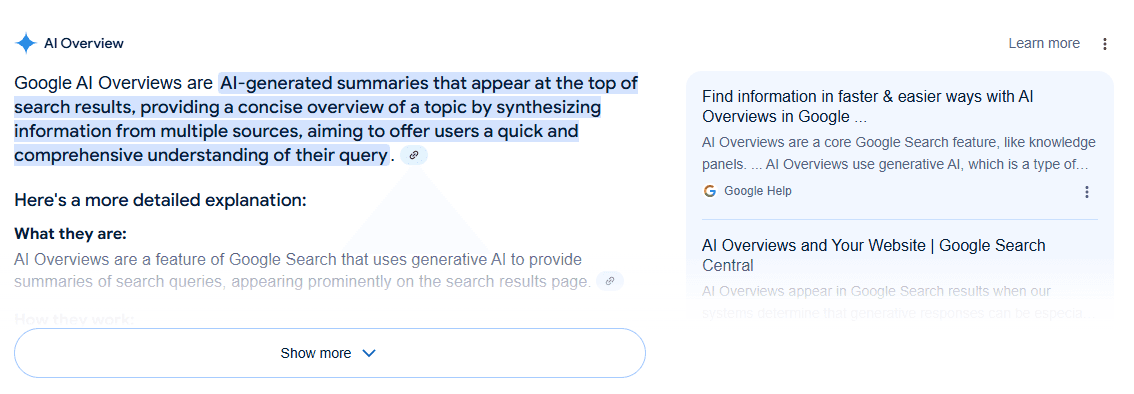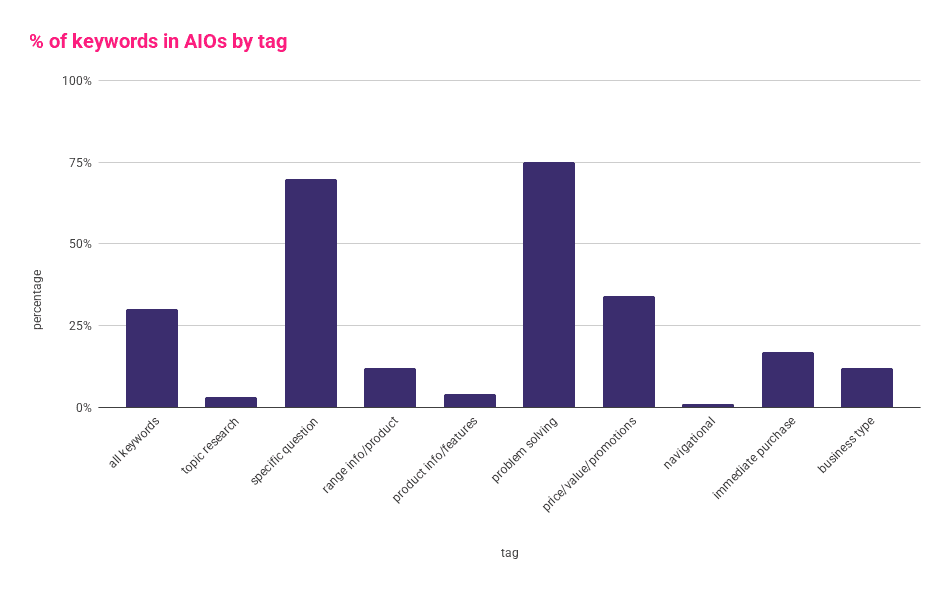
Google AI Overviews: SEO friend or foe?
Written by Gabrielle
Google AI overviews: SEO friend or foe?
It’s been nearly a year since AI Overviews were introduced by Google. And it’s fair to say they shook the SEO world, causing content writers and technical SEOs everywhere to scratch their heads.
- How did this AI-generated search tool work?
- Where was it pulling content from?
- What was its impact on user search behaviours?
In the seven months we’ve had Google AI Overviews in the UK (it was rolled out in the US first in May 2024), SEOs have continued to scramble to understand its implications. Most have befriended it, few have ignored it. But like most search-related changes before it, AI Overviews (AIOs) aren’t without their compromises.
Here’s the lowdown on what you need to know about AIOs, how they’re impacting the search landscape, and our take on whether they’re SEO’s friend or foe.
How do Google AI overviews work?
When you enter a search query into Google, you’ll more than likely see it return a summary generated by AI – an AI Overview. In Google’s own words, this takes ‘more of the work out of searching’. The intention is for Googlers to be able to find what they’re looking for faster, be it an answer to a question about multi-platform SEO or how to migrate a website to the Shopify platform.

Put simply, AIOs absorb information from multiple sources to produce a response that’s optimised to answer the user’s query as succinctly and informatively as possible. But how exactly is Google deciding which bits of content should get time in the spotlight?
Quality
Well, the tech giant says AI Overviews are trained to ‘uphold Search’s high bar for quality’. They rely on the hallmark systems that Google’s ‘finetuned for decades’, so you’d expect that means rolling out content that’s optimised for search and follows EEAT (experience, expertise, authority, trust) principles.
High authority URLs
Naturally, there’s been a lot of discussion and testing of what is – and isn’t – featured in AIOs by SEO pundits. Research by Authoritas found keywords that involved problem solving or answering a specific question were most likely (more than 70%!) to be in an AIO. At the other end of the scale, less than 10% of keywords in AIOs were to do with topic research or product information/features.
They’re also more likely to pull content from websites that have URLs which rank well. No surprises there – we all know how Featured Snippets changed the SEO game. The same’s true for this AI search tool. There’s more than a 60% chance for a site to be featured in an AIO if it has/has had a Featured Snippet, reaffirming how Google rewards sites with authority.

Helpfulness
In the same way, when Google’s systems spot a place where generative AI responses can be particularly useful, you’re more likely to see an AIO appear. Google Search Central gives the example:
If there’s one thing to remember about these overviews, it’s that they favour content that gives users as much useful information as possible.
Impact of AI overview on users
So what’s the problem for SEO? Is there even a problem? Well, the jury’s out. And the verdict probably isn’t set to be as black and white as you’d hope. In fact, it’s somewhat stalled on making a decision.
How, then, are users to know if what they’re reading is right, wrong, or somewhere in between?
The Rise of the AI hallucination
If you’re in the SEO world, you may have recently expanded your vernacular with the term ‘AI hallucination’. Similar to a traditional hallucination, it was coined to show when the AI generated content you’re seeing isn’t as it seems – i.e. it’s incorrect, be that factually wrong or plainly nonsensical.
AI Overview Implications for SEO
And that’s just the start. Expanding an AI Overview on your desktop moves the page down by 220 or so pixels. With more room taken up by the AIO answer, there’s less room for standard content to appear. It’s even worse for content that’s been optimised for mobile searches – only a couple of organic results can be seen unless you scroll down.
More than ever, content needs to add value to the answers it’s giving to user search queries. Brands need to find ways to make content stand out for the right reasons, without deviating from the topic at hand. Providing misleading or overinflated information is a big no-no.
Google Core Update March 2025
It’s also worth mentioning the latest Google core update. Rollout began on March 13th 2025, with the update designed to provide ‘relevant, satisfying content’ from ‘all types of sites’. Core updates usually have SEO teams on high alert – updates affect Google’s search algorithms and can change rankings, for better or worse.
The search giant hasn’t released any advice specific to this update, but reinforced its principle of creating ‘helpful, reliable, people-first content’, something we do here at Flaunt Digital. It remains to be seen how this Google core update impacts AIOs, but one thing’s for sure – our content team’s eyes are peeled!
How to appear in the Google AI Overviews
In the meantime, there are a few tried and tested ways to make it more likely for your content to be included in AI Overviews (in some capacity).
- Continue to follow EEAT principles and best SEO practice.
- Focus on content that solves a specific problem or answers a specific question – the chart above speaks volumes in the types of keywords most likely to be in an AIO!
Include values and figures that are ‘set’ – i.e. they’ve got low/no chance of fluctuating. Google AIOs like content that provides a straightforward answer. If you enter a query like ‘when was the latest Google core update?’ which has a set answer of March 2025 for instance, it’s got a better chance of a generative AI response.
So, what happens next?
It’s always an interesting time to work in SEO, but the rate of evolution we’re seeing at the moment is more of a beast than ever. How Google AIOs change search over the next three, six, twelve months remains to be seen. And you bet our team is here to watch it unfold.





